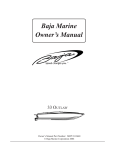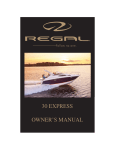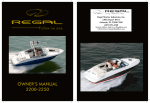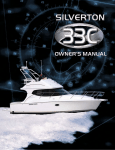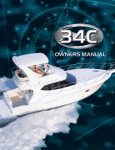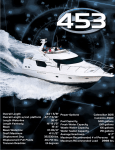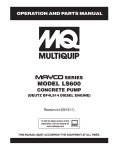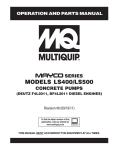Download Regal 52 SC Owner`s manual
Transcript
52 SC OWNER’S MANUAL REGAL #526043 4-2013 Table Of Contents 1 INTRODUCTION Regal Owner’s Manual Owner’s Information Packet General Information Regal Marine Limited Warranty 1-4 1-4 1-5 1-12 2 SAFETY ON BOARD Safety Labels General Boating Safety Required Safety Equipment Fire Extinguishers Visual Distress Signals Sound Protecting Devices Radio Communications Navigation Lights MarineSanitation Devices EBIRB Life Rafts U.S.C.G Minimum Equipment Requirements Exhaust & Carbon Dioxide Boating & Alcohol BoatingAccidents Water Sports Weather & Water Conditions 2-1 2-2 2-4 2-6 2-7 2-10 2-10 2-10 2-10 2-12 2-13 2-13 2-14 2-16 2-18 2-20 2-21 3 RULES OF THE ROAD Navigation Rules Defined Navigation Rules Bridge Clearance 3-1 3-1 3-8 4 SYSTEMS Fuel Electrical Generator Air Conditioner Fresh Water Waste Water Dingy Trim Tabs Sun Roof Windlass Entertainment Electronics 4-2 4-11 4-56 4-61 4-66 4-76 4-84 4-89 4-91 4-92 4-97 4-106 Table Of Contents 5 ENGINE & CONTROLS Overview Instrumentation IPS Engines Controls Joysticks Drive/Propellers 5-1 5-6 5-8 5-14 5-18 5-22 6 VESSEL OPERATION Getting Underway Starting & Stopping Fenders Dock Line Basics Knots Anchoring Towing Admiralty Law Emergencies Environmental Awareness 6-1 6-4 6-5 6-6 6-8 6-9 6-10 6-10 6-11 6-13 7 AUXILIARY EQUIPMENT OPERATION Interior Equipment Component Carbon Monoxide Detector Door-Companionway Grey Water System Hatches Lighting-Cabin Monitor-Water/Waste Portlights Range/Stove Refrigerator Salon Furniture-Dinette Seat-Helm TV-LCD Monitor Precautions Vacuum Cleaner Washer-Dryer Combo 7-3 7-4 7-5 7-6 7-7 7-10 7-11 7-12 7-13 7-15 7-16 7-17 7-18 7-20 Chapter 10 DIESEL GENERATOR (WESTERBEKE) Selected yachts feature Westerbeke diesel generators. If equipped, the generator must be decommissioned for storage in freezing climates. Your Regal dealer or marine professional has special training along with the necessary parts for winterizing your generator. If tackling the procedure yourself, here are the basics of winterizing the generator. Refer to your generator operator’s manual for further information. The vessel must be in the water for the procedures below. Remove any sound shield enclosure as equipped. Change the fuel filter elements on the engine and bleed the fuel system as needed. Start the engine and let it run for 5-10 minutes to make sure no air is left in the fuel system. Check for any leaks that may have been created in the fuel system during this servicing, correcting them as needed. Operating the engine 5-10 minutes will help allow movement of the treated fuel through the injection equipment on the engine. Close the through hull seacock. Remove the raw water intake hose from the fitting. Place the end of this hose into a five gallon bucket of clean fresh water. Before starting the engine check the zinc anode found in the primary heat exchanger on the engine and clean or replace it as required and also clean any zinc debris from inside the heat exchanger where the zinc anode is located. Clean the raw water strainer. Start the engine and allow the raw water pump to draw the fresh water through the system. When the bucket is empty stop the engine and refill the bucket with an antifreeze solution slightly stronger than needed for winter freeze protection in your area. Start the engine and allow all of this mixture to be drawn through the raw water system. Once the bucket is empty, stop the engine. This antifreeze mixture should protect the raw water circuit from freezing during the winter lay-up, as well as providing corrosion protection. Remove the impeller from your raw water pump (some antifreeze mixture will accompany it, so catch it in a bucket). Examine the bucket. Get a replacement if needed and a cover gasket. Do not replace the impeller (into the pump) until recommissioning, but replace the cover and gasket. A 50-50 solution of antifreeze and distilled water is recommended for use in the fresh water cooling system at all times. This solution may require a higher concentration depending on the area’s winter climate. Check the solution to make sure the antifreeze protection is sufficient. If you need to add antifreeze, drain an appropriate amount from the engine block and add a more concentrated measure. Start the engine to ensure a complete circulation and mixture of the antifreeze concentration thoughout the cooling system. Then recheck the antifreeze solution’s strength with a bulb type checker. With the engine warm, drain all the engine oil from the oil sump. Remove and replace the oil filter and fill the sump with new oil. Use the correct grade of oil according to the engine lubricating oil section of your generator operator manual. Run the engine and check for proper oil pressure and make sure it is leak free. Do not leave the old engine oil in the crankcase over the lay-up period. The old oil and combustion products combine to produce harmful chemicals which can reduce the life of your engine’s internal parts. Top off your fuel tanks off with number 2 diesel fuel. Fuel additives such as BIOBOR and STABIL should be added at this time to control algae and condition the fuel. Care should be taken that the additives used are compatible with the primary fuel filter/water seperator used in the system. Change the element in your primary fuel filter/ water seperator and clean the seperator sediment bowl. 6 Storage & Winterization MODELS W/ SEA KEY SYSTEM If you winterize or store your boat for an extended time, and it is not connected to shore power, it is recommended that you put the MSU into off season power mode. The power mode puts the MSU into a very low power state, minimizing the drain on the boat’s battery and the internal battery of the MSU. While in this mode, the MSU will continue monotoring the float switch and SOS button, responding immediately to either alarm. However, the MSU disables the following functions: 1. GeoFence violation 2. Responding to website commands, including polling the vessel’s location and status 3. Battery voltage monotoring Note: If someone attemps to start the engine, power switch alarm will trigger if enabled. Off season can be commanded from the operator mode or from the Sea Key Response Center. Swithching on the main battery and/or starting the engine will stop Off Season and restore normal MSU functions. Enable Off Season Power Mode 1. On the main menu, select Off Season Power Mode. 2. Press the Enter button. The Off Season Power Mode screen will display the instructions. Press the down arrow button to read the instructions. 3. Press the Enter button. to put the SeaKey in Offf Season Power Mode. The Confirm Off Season Power Mode screen is displayed. Read the instructions. 4.Press the Enter button to put SeaKey in Off Season Power Mode and return to the main menu. 5. The Off Season Power Mode is fully activated when the main battery switch is turned to the Off position. 7 Chapter 10 SEA KEY-GLOBAL POSITIONING SYSTEM 8 Storage & Winterization TELEVISION: The television manufacturer recommends that the unit be removed from the vessel in freezing climates. To remove the flat screen do the following: 1. Pull out the power plug from the rear of the television. 2. Unscrew the antenna cable. 3. While someone holds the flat screen, remove the screws that hold the television to the bracket. 4. Remove the television and store at room temperature. 9 Chapter 10 WASHER/DRYER 10 Storage & Winterization WASTE/TOILET SYSTEM: WATER SYSTEM-FRESH 1. Pump out waste holding tank, flush the tank with fresh water and pump out again. 1. Turn on the fresh water pump switch. 2. With non-toxic propylene glycol antifreeze in the fresh water tank, operate head until antifreeze flows into bowl of head. Allow time between flushes for the vacuum to build up. 3. Operate macerator until antifreeze has a steady flow coming from the discharge fitting. Pour non-toxic propylene glycol antifreeze solution in head and flush head as needed to produce enough flow to winterize the macerator. 4. Leave at least 2 gallons of non-toxic propylene glycol antifreeze solution in the holding tank during storage. NOTICE USE A SPECIAL NON-TOXIC ANTIFREEZE IN THE FRESH WATER & WASTE SYSTEM WHICH IS AVAILABLE AT RV AND MARINE DEALERS. DO NOT USE AN AUTOMOTIVE TYPE ANTIFREEZE. IT CAN BE HIGHLY POISONOUS AND CORROSIVE. 2. Open all faucets including transom shower and allow tank to empty. 3. Drain the water heater; shut off water pump switch. 4. Mix nontoxic antifreeze with water in accordance with the manufacturer’s recommendations. 5. Pour solution into the fresh water tank. 6. Turn on fresh water pump switch. 7. Open each cold water faucet one by one beginning with the one furthest away from the tank and purge the system until a steady stream flows from the faucet. Then close the faucet. 8. Repeat step 7 for hot water faucets. 9. Shut off water pump switch. 10. Pour a quart of antifreeze into shower drain. Run the shower pump until a steady stream flows from the discharge fitting. 11. Leave at least 2 gallons of antifreeze solution in the holding tank during storage. 11 Chapter 10 Notes 12 Glossary & Index Following is a brief list of nautical terms useful in everyday Bitter end: the end of a line also the end of an anchor boating experiences and communications. For more line detailed glossaries of nautical terminology we recommend you check your local library, the internet or a marine store Bow: the front, or forward part of the boat for boating books. Bulkhead: the vertical partition or wall of a boat GLOSSARY Cast off: to let go or release Abeam: at right angles to the fore and aft line and off the boat Chine: the line fore and aft formed by the intersection of the side and bottom of the boat Aboard: on or in the boat Chock: deck fitting used to secure or guide anchor or tie Above: the part of the boat on a bavin vessel which is lines above the interor of the boat Cleat: deck fitting with protruding arms around which Aft, After: aft is the boat section toward the stern or back lines are secured of the boat Cockpit: the seating space used to accomodate Admidships: toward the center of the boat from either passengers side to side or rear to front Cuddy: a small cabin in the fore part of the boat Beam: the width of a boat at its widest part Deck: the open flooring surface on which crew and passengers walk Bilge: the lower interior of the hull of the boat 1 Chapter 11 Draft: the depth from the waterline of the boat to the Lee: the side opposite that from which the wind is blowing: lowest part of the boat, which indicates how much water the side sheltered from the wind is required to float the boat Leeward: the direction toward which the wind is blowing Fathom: a measurement of depth; one fathom equals six feet PFD: personal floatation device; required for each person aboard Fender: a cushion hung from the side of a boat to prevent it from rubbing against a dock or against other boats Port: the left side of the boat when facing forward (an easy way to remember the difference between “port” Fend off: to push off to avoid sharp contact with dock and “starboard” is that both “port” and “left” have four or other vessel letters) Shank: the main body of an anchor Fore: the part of the boat toward the bow or front Sheer: the curve of the boat’s deck from fore to aft when Freeboard: the height of the top side from the waterline seen from the side to the deck at its shortest point. (The distance from the sheer or gunwale to the water) Starboard: the right side of the boat when facing forward Galley: cooking area Stern: the aft end of the boat Gunwale: rail or upper edge of the side of the boat Stern drive: an inboard/outboard (IO)unit Hatch: an opening in the deck to provide access below Stringer: strengthening integral unit fastened from fore to aft inside the hull and fiberglass encapsulated for added strength: much like the skeleton system of our body Head: toilet Hull: the part of the hull from the deck down Top off: to fill up a tank IPS: inboard propulsion system by Volvo Transom: the vertical part of the stern. Keel: the lowest point of a boat Trim: the boat’s balance when properly loaded Knots: a measurement of speed indicating nautical miles Wake: the path of a boat left astern in the water per hour 2 Glossary & Index A AC Current AC Panel Accidents Accident Reporting Air Conditioner Alcohol Myths & Facts Antennae Anchoring Autopilot B Batteries Battery Charger Battery Parallel Switch Battery Switches Bilge-Engine Compartment Bilge Pump Bottom Paint Breakers Breaker Panel (Helm) Breast Lines Bridge Clearance C CD Player Cabinet Care Cord Cable System 4-41 9-10 4-49 2-18 2-19 4-61 8-24 9-2 2-18 7-24 8-27 6-9 4-111 Camera Monitoring System Canvas Carbon Monoxide Carbon Monoxide Detector Cardiopulmonary Resuscitation Carpet-Cockpit Carpet-Interior Compass 4-12 8-28 4-20 8-29 9-7 4-26 8-31 4-17 8-3 7-25 8-32 7-26 8-3 9-8 4-19 4-29 4-33 4-34 4-35 6-6 3-8 Cool Cockpit Air Conditioning Corian® Controls D DVD/CD Disc Care DC Panel Dealer Responsibilities Decommissioning Depth Sounder Diagnostic Charts (Troubleshooting) Diesel Fuel Filter Dingy Direct Current (DC) Distress Signals Diver’s Flag Docking Dock Lines Dockside Power (Shorepower) Dockside Water Inlet Door (Cabin Entry/Companionway) Door (Transom) Drain Plug 3 4-102 8-4 4-42 8-34 4-116 7-27 8-34 7-124 8-5 2-14 7-3 8-35 6-11 8-6 8-6 7-28 8-35 7-29 8-9 5-14 4-102 4-33 1-10 10-2 7-113 9-1 4-8 4-84 4-33 9-11 2-7 2-20 6-8 6-6 4-41 4-68 7-4 8-36 7-30 6-1 Chapter 11 E ELCI EVC Display Electrical Electronics Auto Pilot Depth Sounder E- Series Plotter Radar Satellite TV Sirius Marine Weather Sirius Satellite Radio Engine Entertainment Environmental Awareness Exhaust F Fabrics-Interior Fenders Fiberglass Maintenance Fire Extinguishers Fires First Aid Float Plan Flooring Fresh Water System Fuel System Furniture (Salon) G 4-46 5-6 4-11 Technical 4-106 8-36 9-12 4-111 4-113 4-107 4-109 4-101 4-114 8-58 9-26 7-49 Garbage Discharge Gauges/Switch Panels Gelcoat Maintenance General Boating Safety Generator Getting Underway Glossary Granite Ground Fault Outlet (GFCI) H Hardtop Hardtop Enclosure Hatches Heater-Hot Water 5-8 8-65 4-97 10-2 6-14 2-14 High Water Alarm HIN Horn 8-10 6-5 8-11 2-6 7-32 8-38 6-11 6-11 1-7 8-13 4-66 5-29 9-15 4-2 6-3 8-39 7-15 Hull/Deck Hypothermia I IPod Dock Ignition Switch Index Instruments (Gauges) International Distress Signals Isolator-Galvanic K Knots 4 2-12 8-14 8-11 2-2 4-56 7-34 9-18 8-40 6-1 11-1 8-15 4-52 8-50 7-35 7-36 7-6 4-74 7-38 8-51 7-39 8-52 1-5 2-10 8-53 8-17 6-12 7-100 9-23 4-27 11-3 5-6 8-14 9-22 2-9 4-47 9-16 6-8 Glossary & Index L Lights R 2-11 7-7 Range Refrigerator M Maintaining PFD’S Markers-For Slings Mayday Microwave Minimum Required Equipment Monitor Panel Mooring N Navigation Aids Navigation Lights Navigation Rules O Oil Change System Overboard Discharge Pump Overloading Owner Packet Owner Responsibilities P Personal Flotation Devices Plastics Plumbing Connectors Portlights Pre-departure questionaire Propellers Propulsion Pressure Pump-Fresh Water Refrigerator Icemaker Combo Registration Information Remote Control Right-Of-Way 2-6 7-40 2-10 8-17 2-13 7-10 6-6 3-5 2-11 3-1 7-41 8-54 4-79 7-45 8-57 2-3 1-4 1-11 2-4 8-18 8-55 7-11 6-1 5-22 5-1 7-46 8-56 5 7-12 8-18 7-13 9-24 9-25 1-10 5-14 3-1 Chapter 11 S Safety Labels Seacocks SeaKey Seat- Helm Shorepower Shower-Transom Shower Sump Pump Slings-(Lifting) Sound Producing Devices Specifications Spotlight Spring Line Strainer Stainless Steel Stains Stern Line Steering Stereo/CD Player/i Pod Stereo Remote Sunpad/Chaise Lounge Sunroof Swim Ladder Swim Platform Switches (DC) Switches (AC) T 2-1 4-79 8-62 8-57 7-16 4-41 7-48 4-74 8-58 12-22 2-10 Technical 7-51 6-6 4-65 8-16 8-19 6-6 5-14 4-103 8-59 4-103 7-52 4-91 7-54 2-20 7-55 4-34 4-49 Tachometer Technical Drawings Technical Information Television Toilet-Vacuum Style Towing Transformer-Isolation Trim Tabs Troubleshooting U Underwater Lighting Upholstery V VHF Vacuum Cleaner System Ventilation System Vessel Information Sheet Visual Distress Signals W Washer/Dryer Waste Vent Line Filter Waste Water Windlass 6 5-11 9-27 12-11 12-1 7-17 8-60 4-77 8-22 8-63 9-30 6-10 8-61 4-89 8-61 9-1 7-56 8-21 4-117 8-37 7-18 8-64 4-5 1-5 2-7 7-20 8-88 4-78 4-76 4-92 8-90 9-36 Glossary & Index Z Zipper Care 8-5 7 Chapter 11 Notes 8 Technical A portion of the technical drawings found in this chapter are actual product drawings from the Regal factory. These drawings should be of special interest in mechanical and electrical troubleshooting. The equipment in the drawings is discussed in the various sections of this manual. Understanding specific systems and related drawings will go a long ways in solving problems on your vessel. Note that drawings found here may apply to earlier or later yachts. A portion are marked accordingly. Sometimes knowing the brand of a component or system can help identify the correct drawing along with using the particular schematic from the vendor file found in the owner’s information packet. Again, seek professional help as needed. TECHNICAL INFORMATION Note that all product specifications, models, standard, optional equipment, systems, along with the technical information is subject to change without notice. For more information contact your nearest authorized Regal dealer. For the location of your nearest authorized dealer call 407-851-4360 or you can contact Regal through the internet at : www. regalboats.com. Your Regal dealer has received special factory training on the entire product line and his services should be employed to solve more technical problems. 1 Chapter 12 52 SC TYPICAL MACHINERY LAYOUT WINDLASS FRESHWATER WASHDOWN WINDLASS CUT-OUT SWITCH FWD. BILGE PUMP FWD. FLOAT SWITCH WASTE TANK AFT A/C UNIT FWD. A/C UNIT FWD. SHOWER SUMP PUMP WASTE TANK VENT FILTER AFT SHOWER SUMP PUMP FUEL TANK AFT BILGE PUMP AFT FLOAT SWITCH HIGH WATER FLOAT SWITCH OPT. COOL COCKPIT A/C UNIT FRESH WATER TANK FRESH WATER TANK GENERATOR WATER HEATER GENERATOR MUFFLER CORD REEL HOUSE BATTERY ENGINE BATTERIES *Note-Drawing Not To Scale Equipment Location Is Subject To Change 2 Technical Information 52 SC TYPICAL LABEL LOCATIONS SLING POWER SWITCH AT BOW ANCHOR WINDLASS MUST BE IN OFF POSITION WHEN NOT IN USE. SLING *Note-Drawing Not To Scale Labels & Location Subject To Change 3 Chapter 12 52 SC TYPICAL INTERIOR PLANS FORWARD QUEEN W/TWIN BUNK FORWARD VIP STATEROOM *NOTE: NOT TO SCALE 4 Technical Information 52 SC TYPICAL MAIN SHIP’S AC ELECTRICAL PANEL WITH BREAKER SIZES 12-5 Technical Information 52 SC TYPICAL BOSE 321 SYSTEM WITH SATELLITE OPTION (1 OF 2) 12-6 Technical Information 52 SC TYPICAL BOSE 321 SYSTEM WITH SATELLITE OPTION (2 OF 2) 12-7 Technical Information 12-8 52 SC TYPICAL DUAL CHARTPLOTTER WITH AUTOPILOT AND RADAR Technical Information 52 SC TYPICAL MAIN SHIP’S DC ELECTRICAL PANEL WITH BREAKER SIZES 12-9 Technical Information 12-10 52 SC TYPICAL BATTERY MANAGEMENT PANEL Technical Information 52 SC TYPICAL COCKPIT SWITCH PANEL 1OF 2 12-11 Technical Information 12-12 52 SC TYPICAL PORT COCKPIT SWITCH PANEL 2 OF 2 Technical Information 52 SC TYPICAL WINDSHIELD WIPER WIRING 12-13 Technical Information 12-14 52 SC TYPICAL BATTERY CIRCUIT WIRING Technical Information 52 SC TYPICAL DC NEGATIVE (GROUND) WIRING CIRCUIT 12-15 Technical Information 12-16 52 SC TYPICAL DUAL BATTERY CHARGER WIRING Technical Information 52 SC TYPICAL BATTERY CHARGER SYSTEM CONNECTIONS 12-17 Technical Information 12-18 52 SC TYPICAL FRESH WATER PLUMBING LAYOUT Technical Information 52 SC TYPICAL WASTE WATER PLUMBING LAYOUT 12-19 Technical Information 12-20 52 SC TYPICAL OVERALL BOAT DIMENSIONS Technical Information 52 SC TYPICAL WATERLINE DIMENSIONS 12-21 Technical Information WING 147 INCHES 332 INCHES NOTICE TO BOAT OWNER/LIFT OPERATOR: BEFORE LIFTING BOAT PLACE FENDER OR BLOCK BETWEEN STRAP AND HULL JUST UNDER THE SWIM PLATFORM SIDE WING (BOTH PORT AND STBD.) TO RELIEVE STRAP PRESSURE ON WING WHEN LIFTING BOAT. WHEN FENDER POSITIONED CORRECTLY STRAP SHALL NOT PUT PRESSURE ON SIDE WING WHEN FULL WEIGHT IS APPLIED. 12-22 52 SC TYPICAL BOAT LIFTING LOCATIONS (IPS DRIVES) Technical Information NOTICE BOAT OWNER-LIFT OPERATOR Before lifting boat place a fendor or block between strap and hull just under the swim platform side wing (Both port and starboard) to relieve strap pressure on wing when lifting boat. When fender or block is positioned correctly strap will not put pressure on side wing when full weight is applied. FAILURE TO FOLLOW THE ABOVE INSTRUCTIONS MAY CAUSE FIBERGLASS DAMAGE WHICH IS NOT COVERED UNDER THE REGAL LIMITED WARRANTY. BEFORE LIFTING THE VESSEL SEE PAGE 22 OF THIS MANUALS TECHNICAL DRAWING SECTION. FOR FURTHER INFORMATION CALL YOUR REGAL YACHT DEALER OR THE REGAL FACTORY. 12-23









































